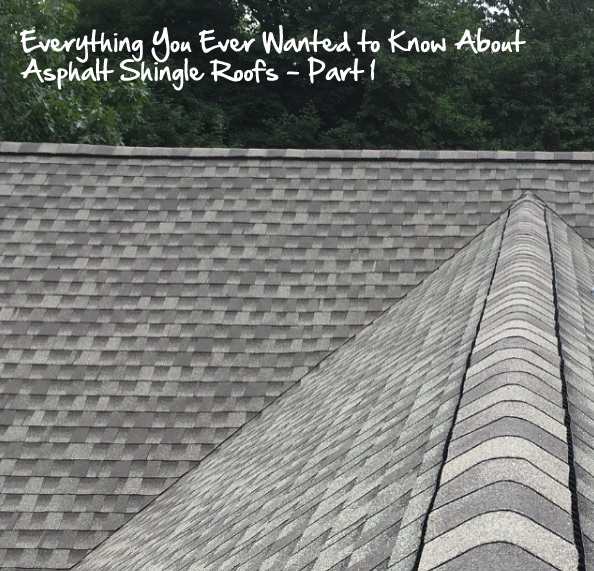In the market for a new roof? If so, we’re betting there’s a lot you don’t know about one of your home’s unsung heroes: the asphalt shingle. For something that you probably give so little thought to, asphalt shingle roofs sure have a big job to do. Not only do the serve as your home’s first line of defense against the elements, they also are increasingly being asked to look darn good while doing their jobs! Your asphalt shingles take on the tough job of fending off rain, snow, hail, wind, leaves, sticks, branches, bird droppings, and more—and they don’t ask for much in return! (What do they need? Find out here!)
When it’s time to choose from the various styles of asphalt shingles, you might be surprised at all the options that are available. But while the sheer number of choices you’ll need to make can feel overwhelming, you have a huge advantage over homeowners of decades past. For one thing, with all the types of asphalt shingles available, there’s sure to be one that perfectly suits your home’s style and the climate you live in, as well as your budgets and tastes. What’s more, not only have asphalt shingles been developed with considerably longer lifespans, huge advancements in roofing technologies have made it possible to, for example, get the look of slate for (much!) less, or the appearance of tile without the fragility that comes with it. So, sit back, relax, and read on to find out why asphalt shingles are so popular!
Asphalt Shingle Facts
The most popular type of roofing material in the U.S., asphalt shingles grace the roofs of millions and millions of homes all over the country. In fact, nearly four out of five American homes have asphalt shingle roofs!
Asphalt shingles are available in two main varieties—fiberglass and organic. Each type is made with a different base of materials. Fiberglass shingles are made of woven fiberglass that’s coated with asphalt and ceramic granules. The asphalt serves as a waterproofing material, while the ceramic granules protect the shingle itself from UV rays. Fiberglass shingles are lightweight, strong, and durable, with a higher fire rating than their organic counterparts. These shingles, which were developed in the ‘80s, are the most common variety used today.
Organic shingles are the original asphalt shingle, with their invention dating back to the start of the 20th century. These shingles are made with natural materials such as wood fibers, cellulose, or felt paper, that have been saturated with asphalt to make them waterproof, then coated with more asphalt as well as ceramic granules. Because they contain so much more asphalt, they’re considerably heavier and costlier. On the plus side, these shingles are more durable and more flexible (especially in cold weather), but they are more likely to absorb moisture and have a lower fire rating. While one might think these so-called “organic” shingles are earth-friendly, the fact that they contain so much asphalt means they’re worse for the environment than their fiberglass counterparts, so they’re increasingly being phased out of use.
The Wide-Ranging Appeal of Asphalt Shingles
Why are asphalt shingles so popular? For one thing, they’re affordable. Asphalt shingle roofs are made of relatively low-cost materials, making them available at attractive price points. These shingles also fairly easy to install, so labor costs associated with asphalt shingle roofs are lower than for other types of roofs. Asphalt shingles are also available in an ever-widening range of styles and colors, making them well-suited to all types of homes. Today, you can even get shingles that are made to look like more expensive materials like slate.
These shingles, which rely on asphalt to make them waterproof, are available in two types of designs: traditional three-tab shingles, which are the most affordable of the two, are flat shingles of uniform size and shape. They’re cheaper of the two main types because they’re thinner and therefore require less material to produce. Three-tab shingles’ more expensive cousins, known as architectural or dimensional shingles, get their name due to their more three-dimensional appearance and shape. It’s these premium shingles that can be styled to look like slate, clay tile, or wood shake.
What to Look for in Asphalt Shingle Roofs, Part II
In our next blog post, you’ll learn more about asphalt shingles that look like natural materials, and the advantages of asphalt of over the real thing. In addition, we’ll talk about asphalt shingle warranties, and explore some of asphalt shingles’ benefits and options in more detail!
In the meantime, if you’re ready to reroof your home—or if you just aren’t sure how much life your current roof has left—give us a call at 973-927-0963! George J Keller & Sons have been roofing homes for over 35 years, so we can advise you on what type of asphalt shingles (or other roofing materials!) are best for your home, budget, and tastes. Call us today for a free estimate on an asphalt shingle roof!
